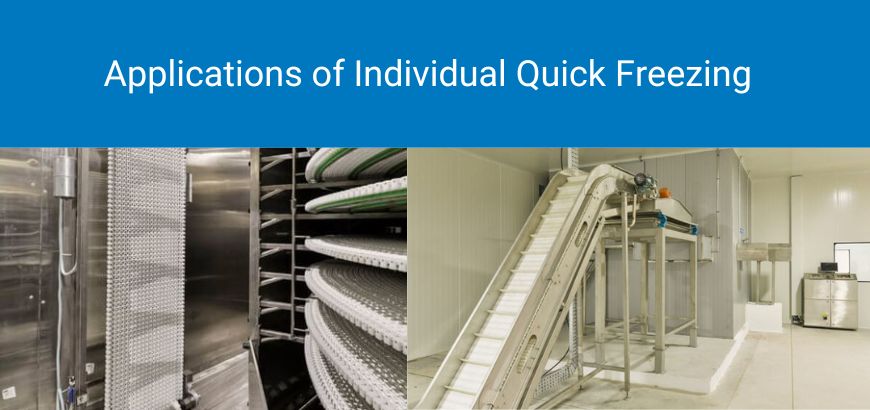Applications of Individual Quick Freezing

Admin
January 2, 2024


January 2, 2024

Freezing is one of the oldest and most effective methods of food preservation. Keeping the texture, flavour, and nutritional value intact, the method also offers the benefits of reduced microbial growth and cellular metabolic reactions. That is why an increasing number of businesses are relying on Individual quick freezing or IQF technology to meet the growing demand for high-quality frozen food products. But do you know what makes IQF the preferred choice and how is it applied in various sectors? Let’s dive in.
Usually, in individual quick freezing the foods are subjected to temperatures ranging from -30°C to -50°C to lower the product core temperature to -18 °C or below. The freezing occurs much faster, preventing the possibility of cellular damage. Also, since each piece is individually frozen, they do not cohere, and the final product is not frozen into a solid block.
Additionally, the process is quick enough to achieve freezing for the micro-crystallisation process, keeping intact the qualities of the food. Thus, any raw, semi-cooked, or cooked food can be quickly and safely frozen, with the right chill and ventilation intensity. In fact, after thawing, there is no change in texture and taste.
IQF is effectively used for fruits, berries, vegetables, fish, seafood, meat, and poultry.
Here’s what a typical IQF process for frozen fruits and vegetables looks like.
During the freezing process, the product’s temperature is lowered, causing most of its water content to transform into ice crystals. As the temperature decreases, the remaining liquid phase becomes increasingly concentrated. Due to the expansion of water when it freezes (ice occupies about 10% more volume than water), the internal pressure within the food can rise significantly. This pressure can lead to undesirable textural changes in the food.
What primarily differentiates slow and quick freezing is the formation of ice crystals. The size of the ice crystals formed during freezing can vary based on the method used.
Characteristics:
Outcome: The larger ice crystals formed during slow freezing can cause more damage to the food’s texture.
A process where the food’s temperature passes through the ice crystal formation zone in 10 minutes or less.
Characteristics:
Advantages:
Outcome: Quick frozen foods are believed to thaw in a condition closer to their original state compared to slow-frozen foods. Moreover, you need not unfreeze the entire product and only the required quantity can be taken out and thawed.
Due to a plethora of benefits including its ability to maintain the quality, taste, and texture of products, IQF finds wide acceptance and adoption across industries. Here’s a quick look.
IQF is extensively used for freezing berries, fruits, and vegetables, both diced and sliced. The rapid freezing ensures that the nutritional value, taste, and texture of the produce are maintained.
IQF is beneficial for freezing seafood, especially smaller items like shrimp and small fish. It ensures that the seafood retains its freshness, taste, and texture.
IQF is used to freeze individual pieces of meat and poultry, ensuring that the products remain fresh and free from freezer burn.
Products like cheese can be frozen using IQF, ensuring that they retain their texture and taste.
IQF is used in the read-to-eat meals sector to freeze pre-cooked meals, ensuring that each component retains its individual taste and texture.